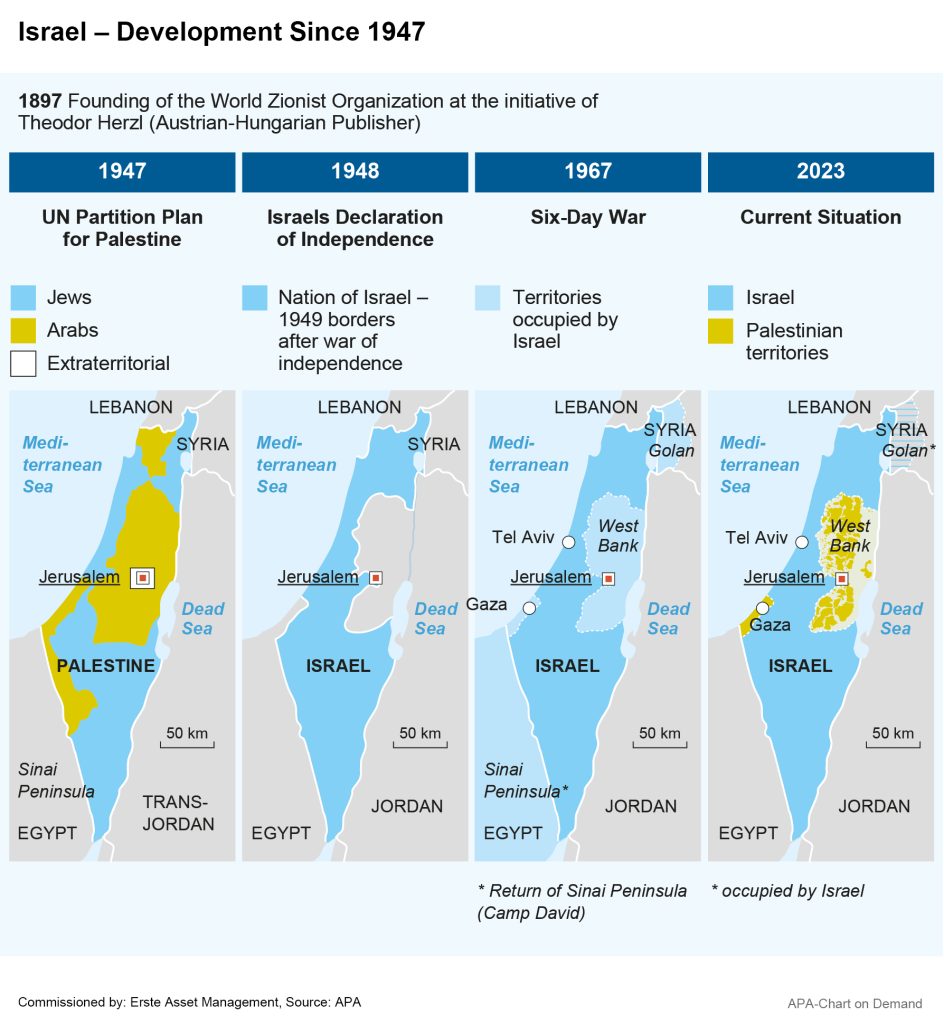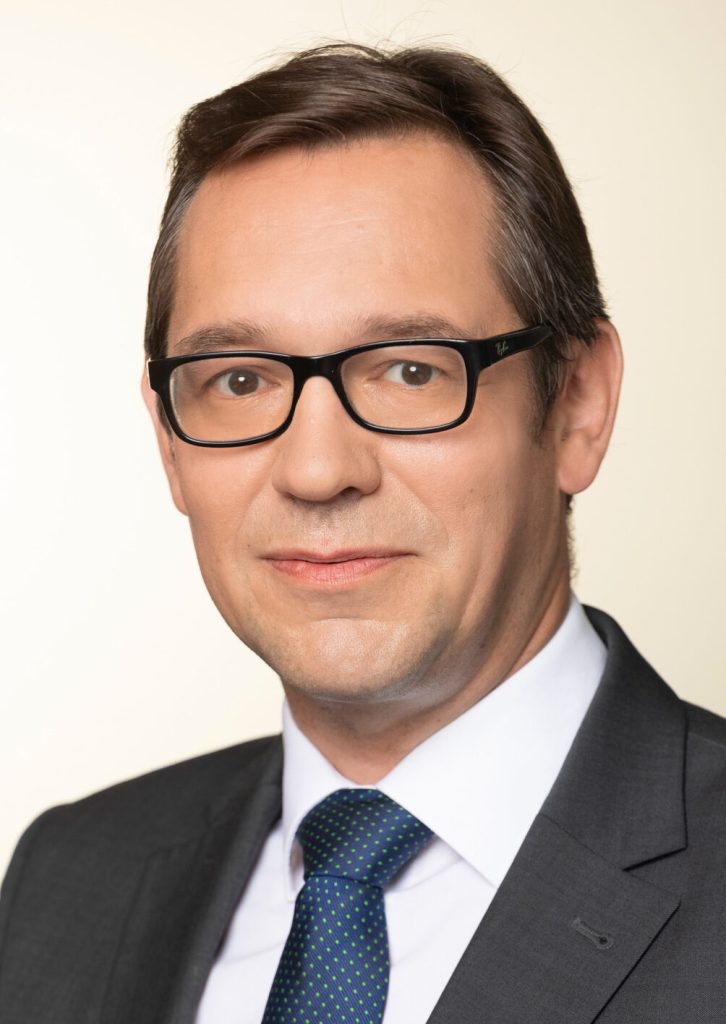
Roughly two weeks after the surprising terrorist attacks by the radical Islamic Hamas ruling the Gaza Strip, on targets in Israel, the military conflict in the country continues unabated. The war in the region also continues to dominate the financial and commodity markets, with global concerns that the conflict could possibly spread to other countries in the Middle East being the main driver of uncertainty.
Gold and Oil Prices Rising
Gold price has risen significantly since the outbreak of the crisis. The price of the precious metal, considered a safe investment in times of crisis, recently reached 1,980 USD per troy ounce (Scource: LSEG Datastream) and is approaching the 2,000 dollar mark.
Crude oil prices also increased, but have recently pulled back somewhat. Just before the outbreak of the crisis, the price of a barrel (159 liters) of the benchmark oil grade Brent crude was just under 85 USD, intermittently rising to not quite 94 USD in recent weeks. on Tuesday morning, prices for Brent held at just above 90 USD (Source: LSEG Datastream).
Please note that investments in securities entail risks in addition to the opportunities.
The oil price is probably the most important channel of impact between the conflict and the global economy, as Erste AM Chief Economist Gerhard Winzer comments. A fast and strong price increase would represent a price shock. This would reduce the purchasing power of consumers and companies, stop the falling inflation trend and increase the pressure on central banks to raise key interest rates further. Economic sentiment would also suffer. All these factors would increase the probability of a recession.
Israeli Ground Offensive Could Be Imminent
Israel’s army has bombed hundreds of targets in the Gaza Strip since the Hamas attack on 7 October, and the Israeli military’s announced ground offensive in the area is expected to commence shorty. Against this backdrop, Israel massively stepped up airstrikes on the Gaza Strip on Sunday night, with Hamas reporting at least 80 dead after the attacks.
Israel’s Defense Minister Yoav Galant anticipates fighting that could last for months. “It may take a month, two or three, but in the end there will be no Hamas,” Galant said on Sunday. Before Hamas meets Israeli forces on the ground, “the enemy” will first face air strikes, he said, adding that the next stage will “come soon,”. The Israeli strategy is to weaken Hamas in preparation for the next phase of the military operation, Lt. Col. Jonathan Conricus told US Fox TV.
Attacks from Lebanon on Israel have also increased since the outset of the war between Israel and Hamas. There is concern that the Iran-backed Shiite organization Hezbollah could further intensify its attacks on Israel. Hezbollah is considered far more powerful than Hamas. The Israeli army accuses the Hamas-allied group of trying to drag Lebanon into a war.

US Prepares for Possible Expansion of Conflict
The US also fears a possible expansion of the conflict in the Middle East. “We are concerned about a possible escalation,” US Defense Secretary Lloyd Austin told ABC television on Sunday. In the last few days, several drone attacks were carried out or attempted on US military bases in Syria and Iraq, according to Pentagon data. The US therefore wants to increase its military presence in the Middle East to protect its own units and send a deterrent message. Austin announced on the weekend that more assets would be moved to the eastern Mediterranean. Previously, the US had moved several warships to the eastern Mediterranean as a deterrent.
US Secretary of State Antony Blinken also expressed alarm. “We are concerned,” Blinken told NBC on Sunday. “We’re taking steps to make sure we can effectively defend our people and respond decisively when we need to.” At the same time, he stressed that the US does not want the conflict to escalate. “We don’t want a second or third front to develop,” Biden stressed. “That’s in nobody’s interest, and that’s exactly why we’ve sent a very strong message to try to deter Hezbollah and more directly also deter Iran from opening a second front.”
Diplomatic Efforts Continue
But efforts to contain the conflict diplomatically are also in full swing, albeit unsuccessful for now. Leaders from around the world called for a cease-fire between Israel and Hamas at a Middle East summit in Cairo over the weekend. This should allow, among other things, “massive” humanitarian aid for the suffering civilian population in the Gaza Strip, UN Secretary-General António Guterres demanded in Cairo on Saturday. Meanwhile, in the Palestinian territory, the first trucks with relief supplies arrived after days of waiting. But “much more” aid is required for the 2.4 million residents of the Palestinian territory, Guterres said. Jordan’s King Abdullah II, whose country like summit host Egypt has been a mediator in the Middle East conflict for decades, also called for an “immediate cease-fire.”
There was no hope for an easing of tensions at the conference, however, partly because Israel was not invited. The summit was also attended by EU Council President Charles Michel and heads of government or foreign ministers of several European countries. Representatives of the United States, Russia, China, Japan and Canada were also present.
Last week, a Brazilian draft resolution on the crisis, which focused on humanitarian aid, was vetoed by the United States in the UN Security Council. The United States has now submitted its own draft to the Security Council. According to diplomatic sources on Sunday, the resolution is primarily concerned with the release of hostages kidnapped by Hamas in the Gaza Strip. It was initially unclear whether and if so, when, the resolution could be submitted to the Council for a vote. Either way, a veto by Russia is considered likely.
Central Bankers and Economists Concerned about Possible Economic Consequences
Economists and central bankers recently warned of the possible economic impact the crisis in the Middle East could have. The conflict could pose challenges to the euro area economy, Greece’s central bank chief Yannis Stournaras said. “Given the fact that the euro area remains a large net energy importer, this is likely to have a stagflationary impact if it becomes a problem,” the ECB Governing Council member told the Financial Times last week.
An accumulation of negative supply shocks (supply chains, gas price, oil price,…) would lead to an increase in long-term inflation expectations, writes chief economist Gerhard Winzer. On the part of central banks, it would probably take an even more restrictive monetary policy, i.e. significantly higher key interest rates, to reduce inflation.

“The escalation in the conflict between Hamas and Israel underlines once again that the quiet geopolitical times are over.”
Gerhard Winzer
Chief Economist Erste Asset Management
The Ifo Institute also sees possible negative consequences for the German economy. “German industry is already affected by the rather weakening global industrial economy anyway,” Ifo President Clemens Fuest told Reuters news agency in Berlin in mid-October. At present, the impact may still remain limited, Fuest said. However, this is likely to change if the US or Iran intervene in the conflict.
According to Winzer, the escalation in the conflict between Hamas and Israel underlines once again that the quiet geopolitical times are over. More frequent and stronger fluctuations in economic growth and inflation could be the result. In theory, this means an increase in risk premiums on the markets, both for equities and bonds.
For a glossary of technical terms, please visit this link: Fund Glossary | Erste Asset Management
Legal note:
Prognoses are no reliable indicator for future performance.
Legal disclaimer
This document is an advertisement. Unless indicated otherwise, source: Erste Asset Management GmbH. The language of communication of the sales offices is German and the languages of communication of the Management Company also include English.
The prospectus for UCITS funds (including any amendments) is prepared and published in accordance with the provisions of the InvFG 2011 as amended. Information for Investors pursuant to § 21 AIFMG is prepared for the alternative investment funds (AIF) administered by Erste Asset Management GmbH pursuant to the provisions of the AIFMG in conjunction with the InvFG 2011.
The currently valid versions of the prospectus, the Information for Investors pursuant to § 21 AIFMG, and the key information document can be found on the website www.erste-am.com under “Mandatory publications” and can be obtained free of charge by interested investors at the offices of the Management Company and at the offices of the depositary bank. The exact date of the most recent publication of the prospectus, the languages in which the fund prospectus or the Information for Investors pursuant to Art 21 AIFMG and the key information document are available, and any other locations where the documents can be obtained are indicated on the website www.erste-am.com. A summary of the investor rights is available in German and English on the website www.erste-am.com/investor-rights and can also be obtained from the Management Company.
The Management Company can decide to suspend the provisions it has taken for the sale of unit certificates in other countries in accordance with the regulatory requirements.
Note: You are about to purchase a product that may be difficult to understand. We recommend that you read the indicated fund documents before making an investment decision. In addition to the locations listed above, you can obtain these documents free of charge at the offices of the referring Sparkassen bank and the offices of Erste Bank der oesterreichischen Sparkassen AG. You can also access these documents electronically at www.erste-am.com.
Our analyses and conclusions are general in nature and do not take into account the individual characteristics of our investors in terms of earnings, taxation, experience and knowledge, investment objective, financial position, capacity for loss, and risk tolerance. Past performance is not a reliable indicator of the future performance of a fund.
Please note: Investments in securities entail risks in addition to the opportunities presented here. The value of units and their earnings can rise and fall. Changes in exchange rates can also have a positive or negative effect on the value of an investment. For this reason, you may receive less than your originally invested amount when you redeem your units. Persons who are interested in purchasing units in investment funds are advised to read the current fund prospectus(es) and the Information for Investors pursuant to § 21 AIFMG, especially the risk notices they contain, before making an investment decision. If the fund currency is different than the investor’s home currency, changes in the relevant exchange rate can positively or negatively influence the value of the investment and the amount of the costs associated with the fund in the home currency.
We are not permitted to directly or indirectly offer, sell, transfer, or deliver this financial product to natural or legal persons whose place of residence or domicile is located in a country where this is legally prohibited. In this case, we may not provide any product information, either.
Please consult the corresponding information in the fund prospectus and the Information for Investors pursuant to § 21 AIFMG for restrictions on the sale of the fund to American or Russian citizens.
It is expressly noted that this communication does not provide any investment recommendations, but only expresses our current market assessment. Thus, this communication is not a substitute for investment advice.
This document does not represent a sales activity of the Management Company and therefore may not be construed as an offer for the purchase or sale of financial or investment instruments.
Erste Asset Management GmbH is affiliated with the Erste Bank and austrian Sparkassen banks.
Please also read the “Information about us and our securities services” published by your bank.


